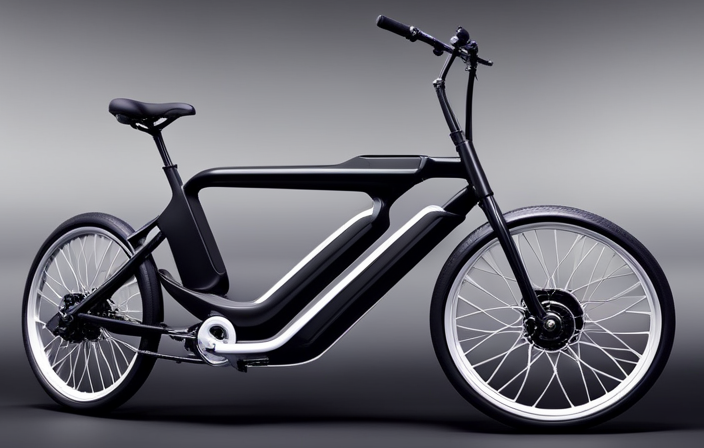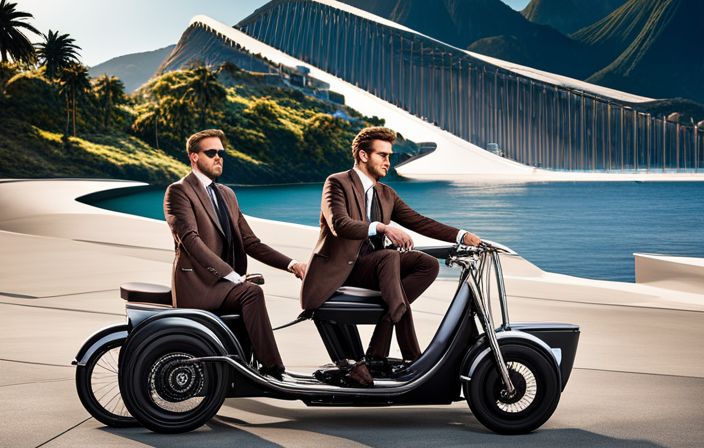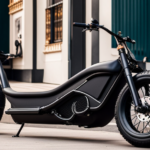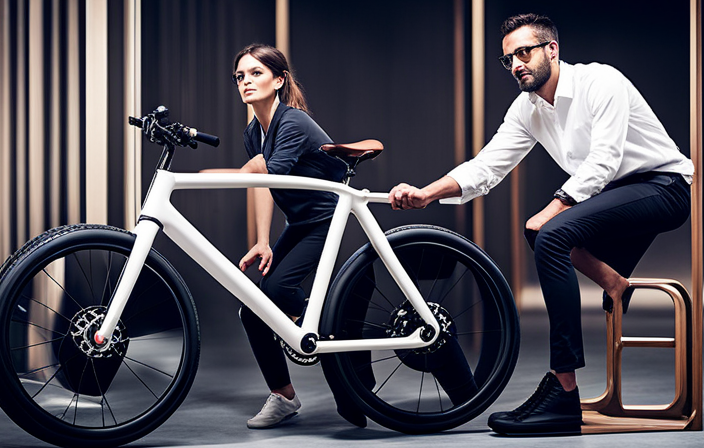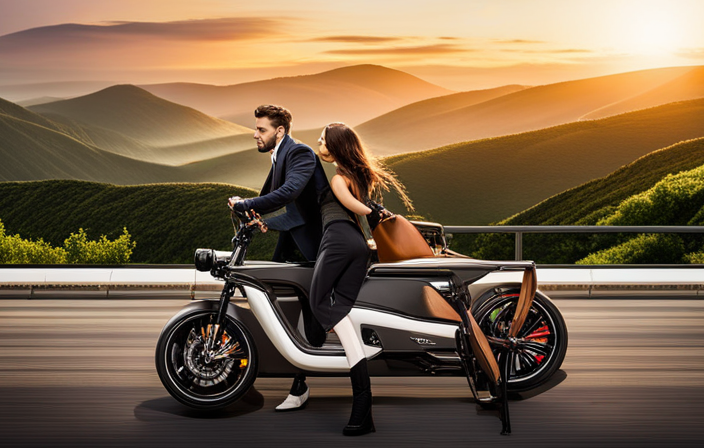Interested in the newest eco-friendly transportation trend? Explore the realm of Class 1 electric bicycles, where the force of pedaling is combined with electric support.
These sleek and innovative machines offer a smooth and efficient way to navigate your daily commute or explore the great outdoors.
In this article, we’ll explore what exactly defines a Class 1 electric bike, how they work, and the numerous benefits they offer.
So buckle up, because we’re about to take a thrilling ride into the world of Class 1 electric bikes.
Key Takeaways
- Class 1 electric bikes have reduced emissions, contributing to cleaner air and reduced pollution.
- They offer health and fitness benefits, such as improving cardiovascular health, increasing muscle strength and tone, and aiding in weight loss.
- Class 1 electric bikes are more cost-effective compared to owning a car, considering the initial purchase price, maintenance costs, and potential savings on fuel and parking fees.
- Popular brands and models of Class 1 electric bikes include Trek Verve+ 2, Specialized Turbo Vado, Rad Power RadCity, and Giant Explore E+.
Definition of Class 1 Electric Bike
So, if you’re wondering what a class 1 electric bike is, let me break it down for you.
Class 1 electric bikes are a specific type of electric bicycle that provide a pedal-assisted ride up to 20 miles per hour. They are equipped with a motor that provides assistance when pedaling, making it easier to ride uphill or for longer distances.
One of the advantages of class 1 electric bikes is that they allow riders to go further and faster with less effort. This makes them a great option for commuting or recreational use.
In recent years, there has been a growing market demand for class 1 electric bikes, as people seek alternative modes of transportation that are eco-friendly and efficient.
Now, let’s move on to how class 1 electric bikes work and the technology behind them.
How Class 1 Electric Bikes Work
One of the coolest things about these pedal-assist bicycles is how they effortlessly blend the power of electricity with the joy of riding.
Class 1 electric bikes utilize a power source, usually a lithium-ion battery, to provide assistance while pedaling. The electric motor functionality kicks in as soon as you start pedaling, providing a boost to your pedaling efforts. This assistance is designed to be smooth and seamless, making it feel like you have a gentle tailwind pushing you forward.
The motor is controlled by a sensor that detects your pedaling cadence and speed, adjusting the level of assistance accordingly. This ensures that the bike provides just the right amount of power to enhance your ride without taking away from the joy of cycling.
Speaking of joy, let’s move on to the benefits of riding a class 1 electric bike.
Benefits of Riding a Class 1 Electric Bike
Experience the exhilaration and freedom of effortlessly gliding through the streets, as if you were soaring on the wings of the wind. Riding a Class 1 electric bike not only provides a thrilling adventure, but it also offers numerous health benefits.
Regular cycling can improve cardiovascular fitness, strengthen muscles, and enhance overall stamina. With a Class 1 electric bike, you can enjoy these benefits while also having the option of using the electric motor to assist you when needed.
Additionally, riding a Class 1 electric bike can lead to significant cost savings. Compared to cars or motorcycles, electric bikes are much more affordable to purchase, maintain, and operate. So, not only can you experience the joy of riding, but you can also save money in the long run.
Transitioning into the next section, let’s explore how Class 1 electric bikes compare to other types of e-bikes.
Comparison with Other Types of E-bikes
Let’s dive into how Class 1 e-bikes stack up against other types of electric bicycles.
When comparing Class 1 electric bikes with Class 2 electric bikes, the main difference lies in the top speed and the level of assistance offered.
Class 1 e-bikes have a maximum assisted speed of 20 mph, while Class 2 e-bikes can reach up to 28 mph. This means that Class 1 e-bikes are more suitable for urban commuting and leisure riding, as they prioritize safety and compliance with local regulations.
Additionally, Class 1 e-bikes have an advantage over traditional bicycles as they provide electric assistance, making uphill climbs and longer distances more manageable.
Now, let’s explore the legal regulations and classification surrounding Class 1 electric bikes, ensuring a clear understanding of their use and benefits.
Legal Regulations and Classification
To navigate the legal landscape and understand how these innovative modes of transportation fit into existing regulations, it’s crucial for riders to be aware of the specific classification and rules surrounding these high-tech two-wheelers. The legal requirements and classification standards for electric bikes vary from country to country and even within different states or provinces. In general, electric bikes are classified into three main categories: class 1, class 2, and class 3. Class 1 electric bikes are equipped with a motor that provides assistance only when the rider is pedaling, and the maximum assisted speed is typically limited to 20 mph (32 km/h). These bikes are often allowed on bike paths and trails where other motorized vehicles are prohibited. Class 1 electric bikes offer a great balance between performance and legal compliance. Moving forward, it’s important to consider the speed and power limitations of these bikes to ensure safety and adherence to regulations.
Speed and Power Limitations
Riders should be mindful of the specific speed and power limitations when it comes to these high-tech two-wheelers. Here are some key points to consider:
-
Speed limitations: Class 1 electric bikes are restricted to a top speed of 20 miles per hour. This ensures a safe and controlled riding experience.
-
Power restrictions: These bikes are equipped with motors that are limited to 750 watts. This ensures that the power output is regulated and doesn’t exceed the allowed limit.
-
Safety first: These limitations are in place to prioritize rider safety and prevent accidents or mishaps on the road.
-
Compliance with regulations: By adhering to these speed and power restrictions, riders can ensure that they are compliant with legal regulations.
-
Enhanced biking experience: Despite the limitations, class 1 electric bikes still offer an enjoyable and efficient riding experience.
Taking these speed and power limitations into account, it’s important to understand the pedal-assist functionality of these bikes, which will be discussed in the next section.
Pedal-Assist Functionality
Get ready to experience a whole new level of biking with the pedal-assist functionality on these high-tech two-wheelers.
The motor power on a Class 1 electric bike provides an extra boost to your pedal strokes, making it easier to tackle hills and ride longer distances. The pedal-assist feature allows the motor to engage only when you are pedaling, providing a seamless and natural riding experience. It ensures that you still get a good workout while enjoying the benefits of motor assistance.
However, it’s important to note that Class 1 electric bikes have speed restrictions, typically limited to 20 miles per hour. This ensures safety and compliance with regulations.
Now, let’s move on to the next section about the battery and range, where we’ll explore how far these bikes can take you without needing a recharge.
Battery and Range
When it comes to electric bikes, the pedal-assist functionality is just one piece of the puzzle. Another crucial aspect to consider is the battery and range.
A Class 1 electric bike is powered by a rechargeable battery, which is typically made using advanced lithium-ion technology. These batteries are lightweight, durable, and offer a high energy density, allowing for a longer range.
The range of a Class 1 electric bike can vary depending on factors such as terrain, rider weight, and assistance level, but on average, you can expect a range of around 40-60 miles on a single charge. Charging options for these bikes are quite versatile, with most models offering the convenience of removable batteries that can be charged either on or off the bike.
With the battery and range taken care of, let’s now explore the environmental impact and sustainability of Class 1 electric bikes.
Environmental Impact and Sustainability
Experience the eco-friendly nature and long-lasting sustainability of these innovative modes of transportation. Class 1 electric bikes are not only beneficial for personal health and fitness, but they also have a positive impact on the environment. With their low carbon footprint and renewable energy integration, they contribute to reducing greenhouse gas emissions and dependence on fossil fuels.
To illustrate their environmental impact, consider the following table:
| Environmental Impact | Benefits |
|---|---|
| Reduced emissions | Contributes to cleaner air and reduced pollution |
| Energy efficiency | Requires less energy compared to other forms of transportation |
| Sustainable materials | Uses recyclable and renewable resources for manufacturing |
| Noise reduction | Operates quietly, minimizing noise pollution |
These bikes are designed to be a sustainable and environmentally-friendly alternative to traditional modes of transportation. Transitioning from this topic, let’s now explore the health and fitness benefits of class 1 electric bikes.
Health and Fitness Benefits
The environmental impact and sustainability of Class 1 electric bikes are undoubtedly impressive. But there’s more to these bikes than just being eco-friendly.
Let’s talk about the health and fitness benefits they offer. Riding a Class 1 electric bike can be a great form of exercise, especially for those who may not be able to engage in high-impact activities due to joint issues or other physical limitations. The pedal-assist feature allows you to control the level of effort you put in, making it an ideal option for individuals of all fitness levels.
Regular cycling can help improve cardiovascular health, increase muscle strength and tone, and even aid in weight loss. So, not only are you reducing your carbon footprint, but you’re also improving your overall health and well-being.
Speaking of well-being, let’s now delve into the cost considerations of Class 1 electric bikes.
Cost Considerations
One interesting statistic to consider is that the average cost of owning a Class 1 e-bike is significantly lower compared to owning a car. This makes electric bikes a more affordable option for those on a budget. When considering the cost of owning an electric bike, it is important to take into account factors such as the initial purchase price, maintenance costs, and potential savings on fuel and parking fees.
Here are a few budget-friendly options to consider when looking for an electric bike:
- XYZ Bike: Known for its affordability and reliable performance.
- ABC Bike: Offers a range of models at various price points to suit different budgets.
- DEF Bike: Known for its durable construction and reasonable price tag.
- GHI Bike: Offers competitive pricing and a good balance between quality and cost.
Transitioning into the subsequent section about popular brands and models, it is important to explore the different options available in the market.
Popular Brands and Models
Now that we’ve discussed the cost considerations of class 1 electric bikes, let’s move on to the exciting world of popular brands and models. There are several well-known brands that have made a name for themselves in the electric bike industry, offering top-notch features and reliable performance. To give you a better idea, here’s a table showcasing some of the most popular class 1 electric bike brands and their best features:
| Brand | Model | Best Features |
|---|---|---|
| Trek | Verve+ 2 | Integrated lights, powerful motor |
| Specialized | Turbo Vado | Customizable motor settings, sleek design |
| Rad Power | RadCity | Long-range battery, comfortable ride |
| Giant | Explore E+ | Responsive motor, high-quality components |
These brands have consistently delivered exceptional electric bikes with features that cater to different preferences and needs. Now that we have an idea of the popular options available, let’s delve into some important safety tips and precautions to ensure a safe and enjoyable riding experience.
Safety Tips and Precautions
Get ready to ride safely and confidently with these essential tips and precautions!
When riding a class 1 electric bike, it’s important to prioritize your safety.
One of the first things you should do is invest in proper safety gear, such as a helmet, knee pads, and elbow pads. These will protect you in case of any accidents or falls.
Additionally, it’s crucial to be mindful of traffic rules and regulations when riding in traffic. Obey traffic signals, use hand signals to indicate turns, and stay in designated bike lanes whenever possible.
Always be aware of your surroundings and anticipate the actions of other vehicles on the road.
By following these safety tips and precautions, you can enjoy a safe and smooth ride on your class 1 electric bike.
Now, let’s move on to the next section about maintenance and care.
Maintenance and Care
To ensure optimal performance and longevity, it is essential to regularly maintain and care for your class 1 electric bike. Here are some important maintenance tasks and tips for extending the lifespan of your vehicle:
-
Keep the battery charged: Regularly charge your electric bike’s battery to maintain its capacity and avoid performance issues.
-
Check tire pressure: Properly inflated tires not only provide a smoother ride but also prevent unnecessary wear and tear.
-
Clean and lubricate the chain: Regularly clean and lubricate the chain to reduce friction and ensure smooth pedaling.
-
Inspect brakes and gears: Check the brakes and gears regularly for any signs of wear or damage, and adjust or replace them as needed.
By following these maintenance tasks and tips, you can keep your class 1 electric bike in excellent condition for years to come.
In the next section, we will discuss whether a class 1 electric bike is the right choice for you.
Conclusion: Is a Class 1 Electric Bike Right for You?
So, if you’re looking for a ride that’s easy on your energy levels and gives you a little boost, a Class 1 e-bike might just be your ticket to a smoother and more enjoyable journey.
When considering whether a Class 1 electric bike is worth buying, there are a few factors to consider.
Firstly, the Class 1 designation means that the bike provides pedal-assist up to 20 mph, making it suitable for most urban and recreational riders. This can be a great option for those who want to save energy during their commute or leisurely rides.
Additionally, Class 1 e-bikes are allowed on most bike paths and trails, making them a versatile choice.
However, if you’re looking for higher speeds or more power, you may want to consider a Class 3 electric bike instead.
Ultimately, it all depends on your personal preferences and needs.
Happy riding!
Frequently Asked Questions
Are Class 1 electric bikes legal to use on all types of roads and pathways?
Yes, class 1 electric bikes are legal to use on all types of roads and pathways as long as they adhere to safety regulations. They provide numerous benefits for commuting and recreational purposes, making them a popular choice among riders.
Can I ride a Class 1 electric bike without pedaling?
Yes, you can ride a class 1 electric bike without pedaling, as it has a throttle. However, the legality of riding without pedaling depends on local regulations. The battery charging time varies, and age restrictions may apply. Extreme weather conditions may affect riding.
How long does it typically take to charge the battery of a Class 1 electric bike?
The charging time for a class 1 electric bike’s battery typically varies depending on the model and battery capacity. It can range from 2-6 hours. It’s important to note that frequent charging may shorten the battery lifespan.
Are there any age restrictions for riding a Class 1 electric bike?
Age restrictions for riding a class 1 electric bike vary by location. In most places, there are no specific age restrictions, but riders must follow safety regulations such as wearing a helmet and obeying traffic laws.
Can Class 1 electric bikes be ridden in heavy rain or extreme weather conditions?
Yes, you can ride class 1 electric bikes in heavy rain. However, it is important to take proper maintenance precautions. To ensure safety, regularly clean and dry the bike, check for any water damage, and inspect the brakes and tires for optimal performance.
Conclusion
In conclusion, after diving deep into the world of Class 1 electric bikes, I can confidently say that these technological wonders are a game-changer. With their efficient motor and pedal-assist system, they provide a seamless and exhilarating riding experience.
Not only are they environmentally friendly, but they also offer numerous health benefits. However, the suspense lies in the question: is a Class 1 electric bike right for you? Only you can answer that, as it depends on your needs, preferences, and local regulations.
But one thing is for sure, exploring the world on a Class 1 electric bike will open up a world of possibilities.
